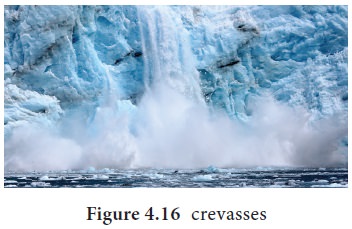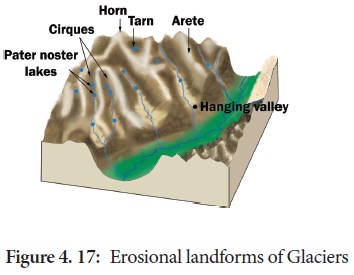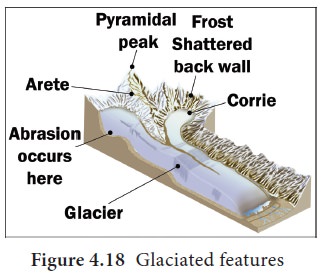Types, Characteristics, Action, Erosional and Depositional landforms - Glacier | 11th Geography : Chapter 4 : Lithosphere: Exogenic Processes
Chapter: 11th Geography : Chapter 4 : Lithosphere: Exogenic Processes
Glacier
Glacier
A glacier is a huge mass of ice that moves slowly
along the mountain slope. The term “glacier” comes from the French word glace which means ice. Glaciers are
often called “rivers of ice”. It
forms where the accumulation of snow exceeds its ablation over many years.
The places where the snow lies for the whole year
are called snowfields. The imaginary
line above which there is a permanent snowfield is known as the snow line. The snowfields are always situated above the snow line. The snow line differs according to
latitude, amount of snowfall, the direction of the wind and the physical
features of the region. Snow starts melting below the snow line. Under the
pressure of the upper layers, the lower layers of the snow field begin to melt
causing the mass of snow to move down slope as glacier. Glacier moves at an
average speed of 1meter per day. Over 96 percent of the glaciers occur in
Antarctica and Greenland.
Types of Glaciers
The Glaciers are of three types. They are;
1.
Continental
Glaciers
2.
Ice
Caps
3.
Mountain
and Valley Glaciers
1. Continental Glaciers
The continental glaciers are found in polar
regions. In these areas, all the precipitation is in the form of snow. The snow
that falls from year to year gradually gets accumulated. As a result, these
regions are covered by an extensive ice mass. This is known as ice sheet or
continental glacier. It is estimated that the maximum thickness of the ice
sheets of Greenland is 3,400 meter, while the maximum thickness of the ice
sheet of Antarctica is 4776 meter. Sometimes, the ends of the ice sheet
projects outwards over the sea. The waves of the sea strike against them and
break the ice sheets into blocks of floating ice known as Icebergs.
2. Ice Caps
It is the covering of snow and ice on the oceans of
poles. The ice caps can cover vast areas with the extensive accumulation of
snow and ice. Example, Svartissen ice cap in Northern Norway.
3. Mountain and Valley Glaciers
These are also known as Alpine glaciers. They flow
like tongues of ice down through the mountain valleys from the ice caps. The
piedmont glaciers form continuous ice sheets at the base of mountains. The
valley glaciers or Alpine glaciers are found in higher regions of the Himalayas
and on all such high mountain ranges of the world.
Characteristics of Glaciers
A moving ice mass or glacier possesses certain
characteristics of movement, speed, and surface structure. The rate of movement
of the glacier is very slow.
The rate of movement or the speed of a glacier
depends upon the size of the glacier and the slope of the valley. Sometimes,
the surface of the glacier forms cracks known as Crevasses. Crevasses are the deep fissure of variable width in the surface of a glacier. These crevasses are
dangerous to the Mountaineers.

Action of glaciers
The glacier performs three actions namely erosion,
transportation and deposition.
A glacier erodes its bedrock by the action of (1)
Plucking and (2)Abrasion
(1) Plucking
The glacier plucks big pieces of rocks from the
valley floor and creates large grooves or hollows. These pieces are dragged
along the valley floor as the glacier moves. The boulders and rocky floor are
grounded by mutual contact.
(2) Abrasion
Pure ice is capable of wearing down massive rocks
when equipped with angular rock fragments. The glacier can groove, scratch, and
chisel the rock surface. It has a powerful abrasive effect.
As a result, a glacier during its lifetime creates
various landforms which may be classified into erosional and depositional
landforms.
Erosional landforms of Glaciers
The landforms created by glaciers are mainly found
in the mountainous regions.
The chief erosional landforms by the glaciers are
as follow:

Figure 4. 17: Erosional landforms of Glaciers
1. U-Shaped Valley
U-Shaped Valley is a typical glacial feature. Since
glacial mass is heavy and slow moving, erosional activity is uniform in all
directions. A steep-sided curved bottom valley has a U shaped profile.
2. Hanging Valley
Hanging valley is formed when tributary glaciers
are unable to cut as deeply as main ones and remain “hanging” at higher levels
than the main valley as discordant tributaries. These tributary valleys appear
hanging over the main valley and enter the main valley at some height.
3. Cirque and Tarn
A Cirque or Corrie is an amphitheater-shaped hollow
basin cut into a mountain ridge. It has a steep-sided slope on three sides, an
open end on one side and a flat bottom. When the ice melts, the Cirque may
develop into a Tarn Lake and the whole thing appears like a big armchair.
4. Aretes
It is a steep-sided, sharp-tipped saw toothed
ridges which have undergone glacial erosion from two sides. These comb like
ridges are called as arete.

5. Horn
If the summit of the Arete is roughly inclined, it
gives rise to pyramidal peaks which are known as horns. Example, Matterhorn of
Alps-Switzerland.
6. Roche Moutonnees or Sheep Rock
Roche Moutonnees or sheep rock is a glaciated
bedrock surface, usually in the form of rounded knobs. The upstream side of a
roche moutonnee has been subjected to glacial scouring that has produced a
gentle, polished, and striated slope and the downstream side has been subjected
to glacial plucking that has resulted in a steep, irregular and jagged slope.
7. Nunataks
A rock mass surrounded by ice is called Nunatak. It
stands out as an island in the ice.
8. Fjord
The fjord is formed as a steep-sided narrow
entrance like feature at the coast of a glaciated region where the stream meets
the coast. Fjords are common in Norway, Greenland and Newzealand.
Depositional landforms of glaciers
When the glaciers melt or recede they deposit the
rock material, brought by them, forming hillocks of various shapes and sizes.
The depositional landforms of the glaciers are;
1. Moraines
Moraines are the piles of dirt and rock that are
deposited by a glacier as it moves across the landscape. These debris fields
exist in places where glaciers have moved through in the past. There are many
kinds of glacial moraines that form. Moraines are generally classified based on
their location.
a) Lateral Moraines
Lateral moraines are ridges of debris that run
parallel to the sides of a glacier. This is often accompanied by scraping of
the valley sides which means the debris from the moraine creates high ridges
above the glacier.
b) Ground Moraines
Ground moraines are glacial depositions formed on
the floor of glacial valley. Ground moraines can be deposited in between
lateral moraines in the case of many alpine glaciers.
c) Medial Moraines
Medial moraines are ridges of debris that are left
down a valley floor at the middle of two glaciers. Both glaciers merge together
and their debris combine to form a consistent moraine field along their
borders. They are actually the merging of two lateral moraines which continue
as medial moraines.
d) Terminal or End Moraines
Terminal or end moraines are left by the end of a
glacier. The slower a glacier moves the bigger the moraine will be as the
glacier has more time to accumulate outside debris.

e) Recessional Moraines
This recessional moraine runs across the landscape
behind a terminal moraine. They are caused by times when the glacier slows or
stops in its movement. It is formed because the receding glacier pauses in
certain places for a long time before continuing its movement.
2. Outwash Plain
When the glacier reaches its lowest point and
melts, it leaves behind a layered deposition of rock debris, clay, sand,
gravel, etc. This layered surface is called as an Outwash Plain.
3. Esker
It is a winding ridge of depositions of rock,
gravel, clay, etc, running along a glacier in an outwash plain. The Eskers
resemble the feature of an embankment and are often used for laying roads.
4. Drumlins
It is an inverted boat-shaped deposition in an
outwash plain caused by deposition.
5. Kames
Kames are the number of ridges formed along the ice
front.
Related Topics